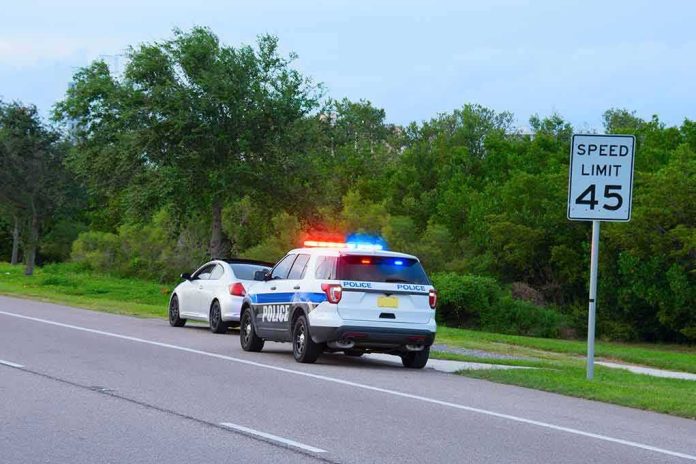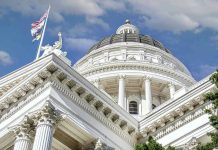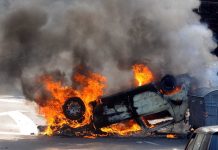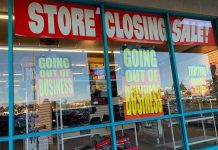
One reckless decision on a Tampa highway set off a chain of devastation that tore through a beloved community space, leaving the city reeling and demanding answers that echo far beyond the scene of the crash.
Story Snapshot
- A street racer fleeing police crashed into the crowded patio of Bradley’s on 7th, killing four and injuring at least thirteen.
- The tragedy occurred at a prominent LGBTQ+ bar in Tampa’s historic Ybor City during peak hours.
- The incident has ignited intense debate over police pursuit policies and urban public safety.
- Community leaders and city officials face mounting pressure to address both enforcement and the vulnerabilities of nightlife districts.
Street Racing Turns Deadly in Tampa’s Nightlife Core
Before 1 a.m. on November 8, 2025, police spotted 22-year-old Silas Kenneth Sampson racing on Interstate 275. Officers attempted to intervene with a tactical maneuver. When that failed, they disengaged, hoping to avoid further escalation. The gamble backfired tragically. Sampson’s car tore off the highway, lost control, and plowed into the outdoor patio of Bradley’s on 7th—a central social landmark in Ybor City—leaving bodies and chaos in its wake. Three died instantly; a fourth succumbed at the hospital. The count of injured, at least thirteen, underscores the scale of destruction and the randomness of being in the wrong place at the wrong time.
The patio, full of regulars and weekend revelers, became a scene of horror. In a neighborhood celebrated for its inclusivity and nightlife, the crash struck at the heart of Tampa’s LGBTQ+ community. Witnesses described a split second between laughter and terror, with tables and people swept beneath twisted metal. Bradley’s on 7th, long a sanctuary for many, now faces a long road to recovery, both physically and emotionally.
Police Pursuit Protocols Under Intensified Scrutiny
Questions erupted almost as quickly as the impact itself: Should the police have continued the pursuit? Law enforcement agencies routinely balance the immediate danger of a high-speed chase against the potential threat posed by letting a suspect go. In Florida, recent years have seen a surge in both street racing and police chases ending in civilian casualties. Critics now point to this incident as a flashpoint, demanding a reevaluation of pursuit policies. The Florida Highway Patrol’s decision to disengage, while intended to minimize risk, failed to prevent disaster—fueling debate over whether current protocols effectively protect the public or merely shift danger from one setting to another.
Proponents of stricter limits argue that urban chases rarely end well, especially in dense nightlife districts where crowds gather late into the night. Others counter that failing to apprehend reckless drivers emboldens illegal street racing, itself a mounting menace. Tampa officials, caught between outcry and responsibility, have promised a comprehensive review while community advocates push for concrete reforms.
Community Trauma, Political Fallout, and the Path Forward
Bradley’s on 7th remains shuttered, its staff and patrons nursing wounds both visible and invisible. Vigils for the victims have drawn hundreds, transforming grief into unity—and into political momentum. The LGBTQ+ community, already wary of violence in public spaces, now calls for enhanced security and city action to prevent similar tragedies. Local businesses fear the economic ripple effects as Ybor City’s reputation as a safe haven comes under threat.
Mayor Jane Castor and city leadership walk a delicate line, expressing condolences while facing demands for policy change. Law enforcement faces its own reckoning, as internal investigations assess the handling of the pursuit and whether tactical decisions can be improved. Urban planners and public safety experts have joined the conversation, advocating for better street design and barriers to protect sidewalk cafes and patios in high-traffic zones. The pressure for answers—why here, why now, what could have been done—remains relentless.
Expert Analysis and Calls for Accountability
Traffic safety experts consistently warn against high-speed pursuits in densely populated nightlife corridors, where the odds of catastrophic bystander injury multiply. Criminologists urge balancing tough street racing enforcement with strict pursuit guidelines, pointing to the heavy toll of past incidents in Florida. LGBTQ+ advocacy groups frame the event as a stark reminder of the fragility of community spaces and the disproportionate impacts of urban violence. While the facts of the crash align across local and national reporting, the broader debate now centers on accountability and reform: How can cities like Tampa safeguard both public safety and vibrant urban life without sacrificing one for the other?
The investigation continues, but the questions raised—and the scars left—will shape Tampa’s policies and community consciousness for years to come. The collision of street racing, law enforcement tactics, and vulnerable public spaces has forced a reckoning that no one in Ybor City, or across urban America, can afford to ignore.









